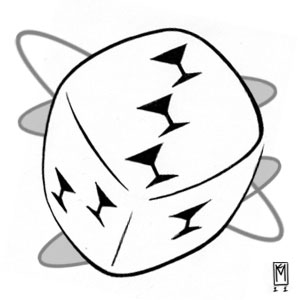Blackthorn Cocktail
 2 oz. Gin (A straightforward London Dry will work well)
2 oz. Gin (A straightforward London Dry will work well)
- 3/4 oz. Dubonnet Rouge
- 3/4 oz. Kirschwasser (I like Schladerer)
Stir in a mixing glass with ice, and strain into a cocktail glass. Garnish with a cocktail cherry and a lemon twist.
~ from "Vintage Sprits & Forgotten Cocktails" by Ted Haigh
Three, as the song says, is a magic number. But even if you aren't familiar with the catchy refrain from one of Schoolhouse Rock's better-known tunes, there's no denying that the number three has a special quality. It resonates with us in a distinctive way, and while many numbers have remarkable characteristics, three stands out and makes itself known in a variety of ways.
A few examples: Anyone who's ever tried to get some time alone with a special person knows that "three's a crowd." If we meet with failure right off the bat, we're urged to keep at it, because the "third time's a charm." "The Five Musketeers" just doesn't sound right, and when it comes to stooges, four is too many but two is clearly not enough.
So naturally we ask ourselves, "How does the number three apply to cocktails?" The answer is: Beautifully.
Three-ingredient cocktails occupy a wonderful niche in the drink universe. Sure, there's something to be said for the near-ridiculous simplicity of two-part drinks like the Gin & Tonic or Screwdriver. They're quick to make, use commonplace ingredients, and are almost impossible to get wrong. But they aren't really the most exciting thing that'll cross your tongue either. On the other end of the spectrum, you've got things like tiki drinks, which often use a boatload of ingredients (usually including a couple oddball items that require effort to find or make), and can take a damn long time to assemble...and that's not including the garnish. They taste fantastic, but you've gotta make the investment. However, three-ingredient drinks manage to hit a great compromise between these two extremes, combining minimalist restraint and flavor complexity that embodies the very concept of balance.
Skeptical? Sure, there's lots of crappy drinks that use three ingredients. It's not a guarantee of quality. "Garbage in, garbage out" was the mantra in my 9th-grade computer class, and it applies to cocktails too. You can recklessly mix three things together lots of times before you get something worthwhile, but when you select the right three components and get their proportions dialed in, it's hard to beat a three-parter. They're quick to make, probably won't require anything too strange ingredient-wise (unless you're like me and enjoy the masochistic pursuit of attempting recipes from pre-1960's bar guides), and have a multifaceted flavor profile.
Still don't believe me? Consider the venerable Sidecar with its immaculate combo of brandy, Cointreau and lemon juice (Any drink that provides the blueprint for the Margarita must be doing something right). How about the Daiquiri? It's hard to think of a finer way to showcase rum than by framing it with a little lime juice and sugar. Don't forget the Negroni, the drink many consider the ultimate expression of the three-ingredient cocktail, employing gin, sweet vermouth and Campari in equal measure.* If you count bitters, the Manhattan is an exemplary three-part cocktail (as is the earlier incarnation of the Martini that used orange bitters). And while we're talking about the brown stuff, let's not forget that at its heart, the Old-Fashioned is a three-ingredient drink. People love to add stuff to it, but it's difficult to improve on whiskey, bitters and sugar.
And if all the above examples sound too high-falutin', bear in mind the Red-Headed Slut is a three-parter as well. Eighty million sorority girls can't be wrong.**
So the next time you're headed to the bar or the liquor store, first grab a pen and write a "3" on your hand as a reminder. It'll be a good guide should you find yourself lost among the bottles or swamped by a gargantuan drink menu. Let Three help you find your way...it's a magic number.
Thanks for drinking!
*I have seen several versions of the Negroni where the ingredient proportions are not equal, but those appear to be an effort to make the drink more forgiving to those who aren't fond of Campari. Drink it however you like, but I maintain that it's best when using the same amount of everything.
** This is an approximate figure.